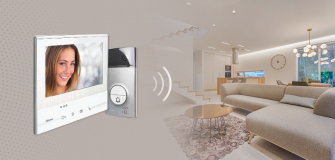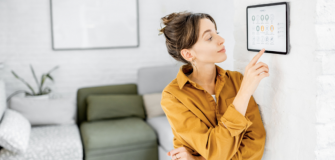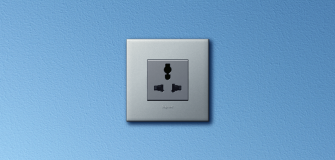What Level Of Importance Do Smart Home Devices Hold In Home Security?
What Level Of Importance Do Smart Home Devices Hold In Home Security?
The concept of a smart home, once relegated to the realms of science fiction, is now an integral part of our daily lives. Home automation and IoT technology have enabled us to control and monitor our homes remotely. While the convenience factor is undeniable, smart home devices also play a pivotal role in enhancing home security.
This transition signifies a monumental leap in how we perceive our living environments. It has necessitated a comprehensive reevaluation of how we safeguard our homes and loved ones. Gone are the days of relying solely on traditional locks and alarms; instead, we have embraced the interconnectedness of smart devices and the power of real-time data to fortify our defences.
This blog will explore how these devices have redefined home security, providing homeowners with innovative solutions to protect their properties and loved ones.
The Intersection of Home Automation and Security
● The Rise of Smart Home Devices
Smart home automation systems are gaining immense popularity, and a significant driver of this trend is their integration into home security solutions. These systems involve interconnected devices and appliances that can be controlled and monitored remotely through mobile apps and voice commands. Homeowners can efficiently manage various aspects of their home, including lighting, temperature, security, and entertainment.
This surge in smart home security is primarily motivated by enhanced safety and convenience. It’s not just about making life easier; it’s also about making homes more secure. Specifically, we can delve into the realm of home security solutions, which include IP Video Door Phone (VDP) systems like Classe 300 EOS, standalone VDP kits, and smart outdoor and indoor cameras. These advanced technologies play a crucial role in creating safer living environments by providing monitoring and surveillance capabilities for homeowners.
● The Role of IoT in Home Security
The Internet of Things (IoT) has emerged as a transformative force at the core of the smart home revolution, reshaping how we think about home security and automation. IoT technology brings unprecedented interconnectedness to our devices, enabling them to communicate with each other, share data, and operate intelligently. This interconnectedness has redefined the landscape of home security, making it more efficient and effective than ever before.
In an era where home security is paramount, the IoT-driven interconnectedness of smart devices has brought about a new level of peace of mind. With real-time data sharing and automation, our homes are not just smarter but also safer. As we continue to embrace and develop IoT technology, we can look forward to a future where our homes are not only secure but also adapt to our needs and preferences seamlessly, making our lives more convenient and secure than ever before.
Imagine a home where your indoor and outdoor cameras, motion sensors, and alarms work in harmony. When a sensor detects suspicious activity, it can trigger the cameras to start recording, alert your smartphone, and turn on the outdoor motion sensor lights to deter potential intruders. This real-time data and automation are powerful tools for home security.
Smart Home Security Systems
1. Smart Outdoor Camera
One of the most critical components of a smart home security system is the smart outdoor camera. These devices are designed to monitor the exterior of your home and provide real-time surveillance. Here’s why they are a valuable addition to your home security:
Features:
- Smart detection: The smart outdoor camera can distinguish between people, animals, cars, and harmless movement, reducing false alarms.
- Alert zones: You can customise which areas the camera monitors, ensuring you’re only alerted to relevant activity.
- No subscription fees: Unlike many security systems, this camera doesn’t come with additional fees for full functionality and app upgrades.
- Data security: Video footage is stored locally on an encrypted MicroSD card, providing peace of mind.
- Easy installation: Replacing an existing outdoor light with this camera is a straightforward process.
- Compatibility: Works with Apple Homekit and Google Assistant for voice commands and integration with other smart devices.
2. Door Phones
In an era where safety and peace of mind are paramount, the Legrand Video Door Phone emerges as a beacon of efficiency and innovation. Whether you’re safeguarding an individual home or managing security for a large building, this Home Security System from Legrand takes center stage, redefining the way we perceive privacy, protection, convenience, and versatility.
3. IP Entrance Panel Keypad: Enhanced Access Control
The IP Entrance Panel Keypad streamlines communication and access control for apartments, residential buildings, and commercial spaces. It offers flexible calling modes, allowing users to enter specific codes for precise access. This includes apartment codes (Area – Building – Riser – Floor – Apartment) and resident alphanumeric codes.
Maintenance personnel can access a settings menu with a specific code to manage features like backlight brightness, ring volume, speaker volume, touch sensitivity, and screen saver time. The keypad ensures secure, convenient, and customisable access management, making it an invaluable tool for seamless communication and control.
Comprehensive Home Monitoring
A home security system is only complete with the ability to monitor extreme weather conditions. Weather stations are becoming integral to smart home setups, providing real-time data and alerts to help you prepare for and respond to weather-related threats.
The Symbiotic Relationship: Smart Devices and Home Security
Smart home devices are more than just gadgets; they serve as a proactive line of defence for your home. Here’s how they work together to create a safer living environment:
Motion Sensors for Lighting: Motion sensors provide convenience by turning on lights automatically when someone enters a room and act as a deterrent to potential intruders. A well-lit property is less attractive to criminals.
Air Quality Monitor: Maintaining good indoor air quality is essential for your family’s health. When air quality drops, you’ll receive alerts, enabling you to take action. In a security context, being healthy and alert is crucial for responding to emergencies.
Weather Station: Extreme weather events can pose significant threats to your home. Real-time data and alerts from a weather station allow you to prepare for storms, floods, or extreme temperatures, minimising potential damage.
In essence, smart devices contribute to a secure and well-rounded living environment. They offer convenience, peace of mind, and real-time information that can make a significant difference in home security.
Conclusion
The integration of IoT technology, smart security systems, and innovative devices like security cameras, air quality monitors, and weather stations has transformed the concept of home security. As the world of home automation continues to evolve, these smart devices are becoming even more crucial, providing homeowners with the tools they need to create a safer and more connected living environment.
Smart home automation systems are no longer just about controlling your lights or thermostat; they are about safeguarding what matters most – your home, family, and peace of mind. With the power of real-time data, interconnected devices, and the convenience of remote monitoring, the smart home is now a vigilant protector of your most cherished assets.




















